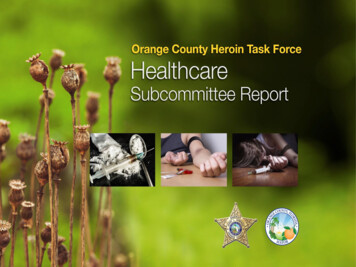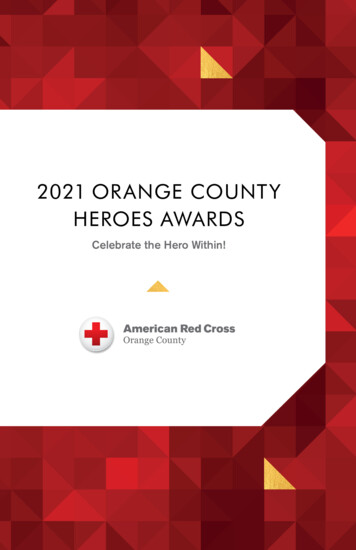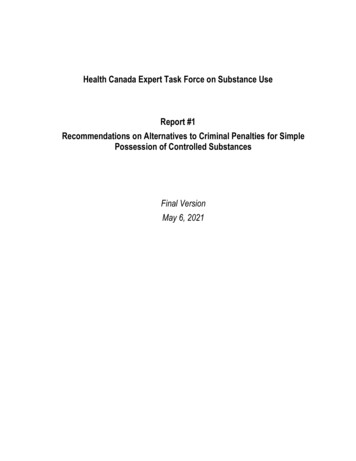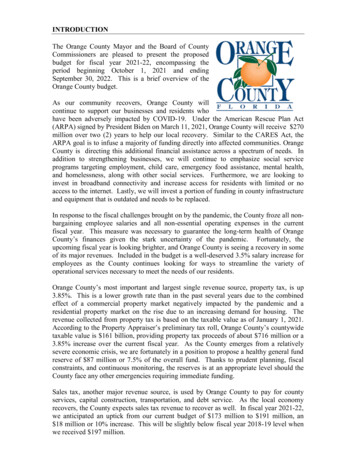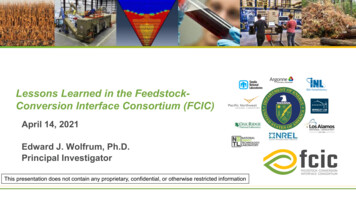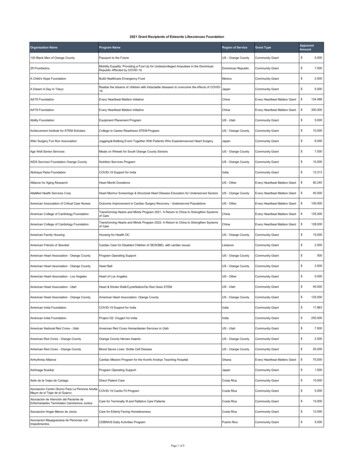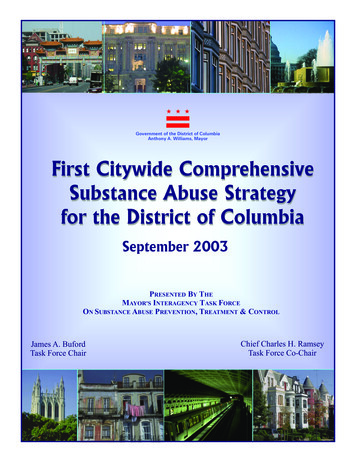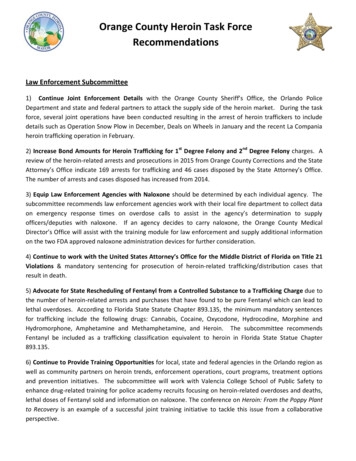
Transcription
Orange County Heroin Task ForceRecommendationsLaw Enforcement Subcommittee1) Continue Joint Enforcement Details with the Orange County Sheriff’s Office, the Orlando PoliceDepartment and state and federal partners to attack the supply side of the heroin market. During the taskforce, several joint operations have been conducted resulting in the arrest of heroin traffickers to includedetails such as Operation Snow Plow in December, Deals on Wheels in January and the recent La Companiaheroin trafficking operation in February.2) Increase Bond Amounts for Heroin Trafficking for 1st Degree Felony and 2nd Degree Felony charges. Areview of the heroin-related arrests and prosecutions in 2015 from Orange County Corrections and the StateAttorney’s Office indicate 169 arrests for trafficking and 46 cases disposed by the State Attorney’s Office.The number of arrests and cases disposed has increased from 2014.3) Equip Law Enforcement Agencies with Naloxone should be determined by each individual agency. Thesubcommittee recommends law enforcement agencies work with their local fire department to collect dataon emergency response times on overdose calls to assist in the agency’s determination to supplyofficers/deputies with naloxone. If an agency decides to carry naloxone, the Orange County MedicalDirector’s Office will assist with the training module for law enforcement and supply additional informationon the two FDA approved naloxone administration devices for further consideration.4) Continue to work with the United States Attorney’s Office for the Middle District of Florida on Title 21Violations & mandatory sentencing for prosecution of heroin-related trafficking/distribution cases thatresult in death.5) Advocate for State Rescheduling of Fentanyl from a Controlled Substance to a Trafficking Charge due tothe number of heroin-related arrests and purchases that have found to be pure Fentanyl which can lead tolethal overdoses. According to Florida State Statute Chapter 893.135, the minimum mandatory sentencesfor trafficking include the following drugs: Cannabis, Cocaine, Oxycodone, Hydrocodine, Morphine andHydromorphone, Amphetamine and Methamphetamine, and Heroin. The subcommittee recommendsFentanyl be included as a trafficking classification equivalent to heroin in Florida State Statue Chapter893.135.6) Continue to Provide Training Opportunities for local, state and federal agencies in the Orlando region aswell as community partners on heroin trends, enforcement operations, court programs, treatment optionsand prevention initiatives. The subcommittee will work with Valencia College School of Public Safety toenhance drug-related training for police academy recruits focusing on heroin-related overdoses and deaths,lethal doses of Fentanyl sold and information on naloxone. The conference on Heroin: From the Poppy Plantto Recovery is an example of a successful joint training initiative to tackle this issue from a collaborativeperspective.
7) Continue to Collect Data on heroin-related law enforcement arrests and operations, corrections bookings,FDLE lab admissions, overdose calls, and prosecutions on a quarterly basis. The data will be collected totrack drug trafficking trends and share information with other subcommittees to effectively tackle theproblem with resources available and measure progress on implementation of recommendations.Education and Prevention Subcommittee8) Launch Social Marketing Campaign and Develop Content for Website Heroes Against Heroin toincrease education and awareness about heroin overdoses and related deaths and provide informationto prevent heroin use among youth, young adults and families. The campaign materials are gearedtoward family and friends and community members. The campaign will also include a Heroes AgainstHeroin App to engage the younger generation on a common platform.9) Collaboration with Media Outlets on public services announcements regarding overdose prevention,treatment resources and recovery support services in the community. The subcommittee will alsolaunch a text messaging campaign such as the 211 Heart of Florida United Way and other social mediaplatforms that provide low-cost options to reach young adults and friends with this information.10) Implement Comprehensive Community Education Strategy to inform educators, parents &guardians, faith-based organizations, neighborhood associations, school resource officers, businesses,apartment complex associations and other key stakeholders about the signs and symptoms of heroinuse, naloxone and overdose prevention, treatment resources and prevention strategies. Theinformation will be available in a toolkit which will include the following: 1) short and long versionpresentations regarding the current heroin problem, warning signs of heroin overdose and overdoseprevention, 2) facts sheets on naloxone to include cost and availability, 3) information on medicationassisted treatment and resources, 4) copy of the recently released FBI and DEA documentary on Chasingthe Dragon: Life of An Opiate Addict and discussion guide - this documentary is appropriate for highschool students, young adults, family & friends and the community, 5) provide parents with third partydrug testing resources, and 6) infused drug education curriculum on opiates and other drugs for firstyear college courses.11) Continue Professional and Community-Based Trainings with educators, colleges, law enforcement,treatment professionals, courts, corrections, faith-based organizations, prevention professionals,parents and guardians, family and friends. The training would provide the latest research and statisticson heroin use and overdoses, naloxone and overdose prevention, medication-assisted treatmentoptions, and prevention initiatives to combat the problem.12) Expand Campus-Based Collegiate Recovery Communities that provide additional resources forcollege students in recovery from substance use disorders. Campus-based recovery communitiessupport sobriety by offering the following programs and services: 1) recovery coaching, 2) access tocampus-based self-help meetings, 3) recovery-centered academic and career advising, 4) designatedspace for students in recovery to study, socialize, and support one another, and 5) opportunities toprovide campus and community service.
13) Increase Training and Awareness for Medical Professionals and Clinicians on heroin use andoverdose prevention in collaboration with the Healthcare Subcommittee. The trainings will includeMotivational Interviewing and Screening, Brief Intervention and Referral to Treatment (SBIRT) which areboth evidence-based programs as well as safe prescribing, education on naloxone and medicationassisted treatment options and resources available in the community.14) Continue to Collect Data on Heroin-Related lifetime and past 30-day use by youth and youngadults through the Florida Youth Substance Abuse Survey, Youth Risk Behavioral Survey, CORE Survey,American College Health Assessment, UCF Student Health Services/Sociology Department survey andfocus group, Orange County Household Survey and other related surveys on a quarterly/annual basis.The survey information will be used to track trends and share information across multiple disciplines.Data will also be collected on the number of heroin-related presentations and vendor displaysconducted by subcommittee members. The information will include the target audience, survey ifapplicable, participants reached, and the number of materials disseminated.15) Create Speaker’s Bureau to train community partners on the heroin toolkit presentations (short andlonger version) and develop a list of speakers from various disciplines (educators, treatmentprofessionals, clinicians, law enforcement and prevention professionals) to provide presentations in thecounty. Information on the Speaker’s Bureau will be made available on the heroesagainstheroin.orgwebsite with a downloadable form to request a speaker.Additional Consideration: Further work needs to be done to explore ways to connect with the Mayor’sYouth Mental Health Task Force and the Central Florida Commission on Homelessness as it pertains toeducation, prevention and training around heroin-related use and overdoses.Healthcare Subcommittee16) Advocate for Increased Access to Naloxone via the Authorization of Standing Order Languageunder the Florida Emergency Treatment and Recovery Act. The proposed legislation will allow forexpanded access and distribution of naloxone and permit pharmacists to dispense naloxone under astanding order (Request modification to the Emergency Treatment and Recovery Act Florida Statute381.887).17) Initiate Pilot Project to Increase Access and Distribution of Naloxone by Identifying High-RiskGroups that have been treated at the Emergency Room, admitted into a Treatment Facility or seen inanother healthcare setting for heroin addiction. The subcommittee supports providing a naloxoneprescription as part of the discharge plan for high-risk patients.18)ImplementImplementProgramfor At-RiskHeroin-Addictedat OrangeCountyJail which18)PilotPilotProgramfor At-RiskHeroin-AddictedInmates atInmatesOrange CountyJail whichincludesincludes preventionoverdose educationpreventioneducationdistributionof naloxoneforatidentifiedat theoverdoseanddistributionandof naloxonefor identifiedinmatesthe OrangeinmatesCounty JailOrangeCountyand educationand screeningfor the Vivitrol lscreeningfor the Vivitrol injection (prescriptioninjectablemedicationto prevent relapsemedication dependenceto prevent afterrelapseopioid/heroinafter detox)and treatmentservicesopioid/heroindetox)and treatmentdependenceservices in partnershipwith FloridaAlcohol andDrug inpartnershipwith FloridaAlcoholandVivitrol Drug AbuseAssociation(FADAA)approvedVivitrol providers. TheAbuseAssociation(FADAA)approvedproviders.The pilotprogramwould involvecollaborationpilot programwould Correctionsinvolve collaborationamongOrange County Corrections Health Services, OrangeamongOrange CountyHealth Services,Orange
County Corrections and treatment providers to identify, educate, screen, provide the Vivitrol injectionand prepare the inmate’s discharge plan for treatment services to be continued once released. TheCommunity Corrections Division (CCD) will work with FADAA approved Vivitrol providers oninformation and educational sessions for clients and family members to learn more about the program.CCD will also work on educational handouts and public service announcements on overdose preventionand information on the administration of naloxone (Recommendation from the Corrections NaloxoneSub-Workgroup).19) Advocate for Mandatory Continuing Education Requirement for Physicians and Nurses on opiatemisuse and heroin abuse, naloxone overdose prevention and prescribing and substance abuse. Thesubcommittee will work with the Florida Board of Medicine and the State Board of Nursing to advocatefor a dedicated course on this topic.20) Increase Awareness and Education among Physicians and Other Medical Providers on the currentheroin problem, signs and symptoms, medication-assisted treatment, safe prescribing and prescribingnaloxone as part of the standard of care for opiate/heroin users. The subcommittee would prepareFAQ’s on the Florida Emergency Treatment and Recovery Act, review the civil and criminal immunitywhen prescribing to a patient or third party and work with the Orange County Medical Society, FloridaCollege of Emergency Physicians, Primary Care and Family Physicians, American College of Physiciansand Florida Medical Association on distribution of information and webinars on each of these topics.21) Create Informational Handouts and Brief Video on Naloxone for medical providers and consumersto include: when and how to use naloxone (two FDA approved administration devices), the cost andwhere it can be purchased. The subcommittee will work with pharmaceutical providers for educationalinformation as it pertains to availability and cost.22) Advocate for Appropriate and Adequate Increases in Funding for Detox Beds, Ambulatory Detoxand Care and Coordination for opiate/heroin addicted patients. We need to address the problem atmultiple levels such as, where and how we are referring patients to ensure the appropriate level of careand treatment modality (Joint Recommendation Supported by the Treatment Subcommittee).23) Increase Communication and Collaboration between Treatment Programs and Obstetric andPediatric/Neonatal healthcare providers in order to facilitate therapy for infants at risk of NeonatalAbstinence Syndrome and to connect the family with necessary services after delivery.24) Early Referral of New Opiate/Heroin Addicted Patients for medically assisted therapy duringpregnancy in order to improve consistency of maternal therapy, to adjust maternal dosing duringpregnancy as needed with the goal of eliminating the use of illicit opiates and to reduce mother’smaintenance opiates once she has delivered so that she may be better able to care for the infant.25) Advocate for Increased Funding for Data Collection and Provide Quarterly Reports to track the mortality and morbidity of heroin use and measure the25) Advocate for Increased Funding for Data Collection and Provide Quarterly Reports to track themortality and morbidity of heroin use and measure the progress of the initiatives implemented. The2) Medical Examiner Heroin-Related Deaths, 3) Treatment Admissions (Public and Private), 4) Health Department Data, 5) Law Enforcement Arrests fordata collectionpoints wouldbut 7)notlimitedto: 1) Trafficking/Distribution,6) FDLE includeLab Admissions,CorrectionsHeroin-RelatedBookings, 8) CorrectionsProgram on NaloxoneVivitrol vey,and12) CORE 4)Essence), 2) Medical Examiner Heroin-Related Deaths, 3) Treatment Admissions (Public and Private),progress of the initiatives implemented. The data collection points would include but not limited to: 1) Emergency Room Admissions (AHCA and Essence),and College Health Assessment Survey.
Health Department Data, 5) Law Enforcement Arrests for Possession, Trafficking/Distribution, 6) FDLELab Admissions, 7) Corrections Heroin-Related Bookings, 8) Corrections Pilot Program on Naloxone andVivitrol 9) Neonatal Abstinence Syndrome Admissions, 10) Florida Youth Substance Abuse Survey, 11)Youth Risk Behavioral Survey, and 12) CORE and College Health Assessment Survey.26) Launch Town Hall Meeting in Collaboration with the Education and Prevention Subcommittee toincrease education and awareness on the current heroin problem (signs and symptoms), provideinformation on naloxone (administration, availability, cost) and medication-assisted treatment optionsand resources in the community, preview the social marketing campaign and review the task forcerecommendations and action plan. The audience will include but not limited to: parents & guardians,parent associations, families and friends, businesses, apartment complex associations, neighborhoodassociations, faith-based leaders, educators, medical associations, and college peer educators.Treatment Subcommittee27) Increase Access to Naloxone by supporting the authorization of standing order under the FloridaEmergency Treatment and Recovery Act. This legislation will allow for expanded access and distributionof naloxone and permit pharmacists to dispense naloxone under the standing order (Modification tothe Emergency Treatment and Recovery Act Florida Statute 381.887).28) Issue a Letter from the Task Force Members asking treatment agencies to prescribe naloxone atdischarge to all heroin dependent clients.29) Advocate for Increased Funding for Detox Beds and Ambulatory Detox for heroin addictedpatients. The Department of Children and Families, Orange County and local Providers will workcollaboratively to identify additional funding opportunities for detox beds and/or ambulatory detoxthrough federal, state or local funding (Joint Recommendation with Healthcare Subcommittee).30) Increase Education for Ambulatory Detox for medical professionals and clinicians working withheroin addicted patients. The education would include information on what type of patients areappropriate for treatment and what supportive services are required for the safety of the patient andthe success of the treatment modality.31) Expand Data Collection to include Treatment Admissions for heroin addicted clients from publicand private providers for ongoing analysis and assessment on the number of treatment admissions,utilization of services and the need in the community.32) Increase Communication and Access to Medication-Assisted Treatment options and Naloxone tomedical providers and family members for those addicted to heroin. The three FDA approvedmedications for treatment for those addicted to opiates including heroin are: buprenorphine,methadone and extended-release injectable naltrexone. There are also two FDA approved naloxoneadministration devices on the market that can reverse the effects of an opiate/heroin overdose whenadministered promptly and appropriately to an overdose victim which are the auto-injector and nasalspray. Naloxone can also be administered by injection.
33) Review Capacity for Transitional Housing and Zoning Guidelines in the Central Florida Area forindividuals coming out of a residential treatment setting in the community. It has come to the attentionof the subcommittee that individuals on medication-assisted treatment are harder to place intransitional housing as well as lack of funding for transitional housing from federal partners as theHousing First model is implemented. The subcommittee will also look at opportunities with faith-basedorganizations regarding transitional or permanent housing models for those in recovery.34) Create a Comprehensive List of Substance Abuse Providers (public and private) in Orange Countythat can be easily accessed by the community via the web, social media, and print format. Ensure theproviders list is distributed to the Heart of Florida United Way 211 Call Center for cross-referencing withtheir database.35) Propose Contract Condition for Substance Abuse Treatment Providers to Register with 211 for theFlorida Department of Children and Families substance abuse service contracts (effective July 1, 2016 fornew contracts) and Orange County Government substance abuse service contracts (effective October 1,2016 for new contracts). The 211 registration process is a free service for providers that can connectresidents to the organization and it is a free and confidential service that operates 24/7 for communitymembers when seeking information or social services in Orange County.36) Develop User-Friendly Informational Handouts and Web content as part of a comprehensiveeducational strategy on how to access treatment and recovery support services in the community andon college campuses with the Education and Prevention Subcommittee. This should include educatingthe public about substance abuse to help combat the stigma and include information that addiction is abrain disease and encourage individuals to seek treatment.37) Facilitate an Ad Hoc Committee to “keep the fire burning” beyond the function of the task forcethrough the continued commitment to building relationships within the stakeholder community, andincrease communication across programs and jurisdictions. This is an opportunity for any stakeholder tocall a meeting when confronted by a systemic and/or consumer based issue for processing andstrategizing resolutions through the leveraging of resources, knowledge and spheres of influence.
Degree Felony and 2 nd Degree Felony charges. A review of the heroin-related arrests and prosecutions in 2015 from Orange County Corrections and the State Attorney's Office indicate 169 arrests for trafficking and 46 cases disposed by the State Attorney's Office. The number of arrests and cases disposed has increased from 2014. 3)
